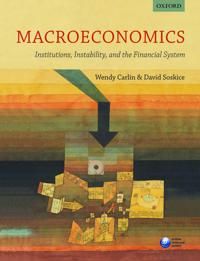Välkommen tillbaka till Campusbokhandeln! Vi firar med inlämningskampanj: Lämna in din kurslitteratur – få 150 :- och chansen att vinna 1 000 :-. Läs mer här!

Macroeconomics | 0:e upplagan
- Pocket, Engelska, 2014
- Författare: David (school Professor Of Political Science And E Soskice
- Betyg:
Välj skick:
Bästa pris
580
kr
Skickas inom 2-3 vardagar
Du sparar 455 kr
(44%)
mot nypris
1035
kr
Skickas inom 5-7 vardagar
820
kr
Skickas från säljare inom 1-3 vardagar
Maya
, Umeå
Verifierad säljare
Ny säljare
Du sparar 215 kr
(21%)
mot nypris
Butikslager
Onlinelager
2 st i lager
Beskrivning
This authoritative new textbook integrates the modern monetary framework, based on the 3-equation model of the demand side, the supply side and the policy maker, with a model of the financial system. As a result, the authors comprehensively address the limitations of the mainstream macroeconomic model exposed by the financial crisis and the Eurozone crisis. The book guides the reader through the three principal steps required to integrate the financial system within the macroeconomic model. Firstly, the authors examine how the margin of the lending rate over the policy rate is set in the commercial banking sector, how money is created in a modern banking system and how the central bank can take account of the working of the banking system in order to achieve its desired policy outcome. Secondly, the authors explore the characteristics of the financial system that result in vulnerability to a financial crisis, with implications for fiscal balance. The economy depends on the continuity of core banking services and governments cannot afford to let them fail. This means that important banks do not bear the full cost of their lending decisions.As a result, they may have an incentive to take on excessive risk. Thirdly, a simple model is developed of the behaviour of highly-leveraged financial institutions as the basis for a leverage or financial cycle in the economy. In addition, the book extends the 3-equation model to the open economy and uses a simple 2-bloc version of the 3-equation model to introduce global imbalances. The case of a common currency area is handled within the core model - both at the Eurozone level and at the level of member countries. Every chapter emphasises how the different actors in the economy behave and interact: what are they trying to achieve and what limits their ability to put their intentions into practice? This is extended to the modelling of growth, where the role of innovation rents in the Schumpeterian model is highlighted. It is essential that students understand previous periods of growth, stability and crisis in preparing for future shocks. With this in mind, the book enables the reader to interpret long run historical data and to compare institutional detail in different eras and across the world.Consequently, this text not only develops the critical thinking skills required for academic success, but ensures the reader can analyse data, trends, and policy debates with the confidence necessary for a career in economics or finance. As a result, it is essential reading for all those interested in learning more about the current macroeconomic system and the role played by financial institutions. Online Resource Centre: For students: Conduct a range of exercises with the closed and open economy versions of the model using the Excel-based macroeconomic simulator. Develop your understanding with additional technical material available in the accompanying web appendices. For registered lecturers: Access the solutions to end of chapter questions from the book.
Produktinformation
Kategori:
Ekonomi & management
Bandtyp:
Pocket
Språk:
Engelska
Förlag:
Oxford University Press
Upplaga:
0
Utgiven:
2014-11-20
ISBN:
9780199655793
Sidantal:
672